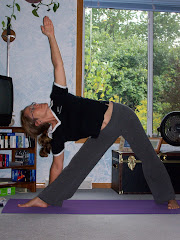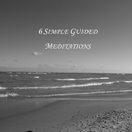What is it to live a "whole life?" Gail Straub suggests in her book, The Rhythm of Compassion, to see balance as the inhale and exhale of every breath: "I've come to think of [the] relationship between soul and society much like following the in-breath and the out-breath, as in meditation practice. There's a natural time for the in-breath of caring for self and family, and a natural time for the out-breath of caring for the needs of the world. The challenge is to become skillful in following our rhythm--knowing when it's time to go inward and when to go out into the community." (Page1.)
Wholeness is found when we reflect and nourish within while balancing that with giving and taking action. A full life is all about balance, and yoga is a tool that can be utilized to find this state of harmony.
A yoga sequence can be customized around the ideas of balance or wholeness. Ideally any yoga class adheres to the guidelines of bringing equanimity and fullness to life, but a focus on twists uncovers imbalances rather quickly. Whereas a whole body practice, sarvanga sadhana, involves all parts of the body including the internal organs. The Viniyoga tradition advices such a complete sequence at least once every 20 days. I find this guideline useful in avoiding burn-out from spending so much time with the poses. It enables you to have a specific focus during the week, while still checking in with the entire system periodically. This is a wonderful way to catch something before it gets out of hand and to maintain the body as a whole.
The body and mind are inseparable. So this endeavor may appear on the surface as strictly physical; when in reality working with the body and the breath directly impacts the mind and thus our lives.
Love Much,
Kris
www.TotalHealthYoga.com
Today is the first day of the rest of your life!



6 comments:
Great post - I love the idea of balancing internal and external energies, both microcosmically (how one conserves/expends one's own energy) and macrocosmically (moving from small family units to larger outreach). Thanks! :)
I agree - great post, Kris!
As always, naturally! Have you been doing the sarvanga sadhana from Gary Kraftsow's book?
xo
Hey Ladies,
Yes I use the sarvanga sadhana in Yoga for Transformation by Kraftsow and also one that he created on the fly during a workshop he gave in Indiana last year. I've tried others, but something about the way he sequences and what he selects for postures really works for me.
As part of the self-love aspect of a lovingkindness practice we can reflect back to the yogic practice of Ahimsa (non-violence, non-harming.) We must remember as we strive to fill our hearts, minds and actions with loving kindness that we are only human, and we will often fall short of our ideals. In those moments we must embrace Ahimsa and not react violently towards ourselves, but rather use the next moment as an opportunity to start once again in the mindset of lovingkindness by offering it with gentleness and compassion to our selves.yoga teacher training course
Indeed, that is right. Is there any difference between yoga and meditation?
It depends on what type of yoga we're talking about and what one means by meditation. Raja Yoga is focused on meditation, while Hatha Yoga uses the body to find liberation. Karma Yoga is about "correct" action; I would say about dharma or life purpose. Meditation is sometimes referred to visualization and almost hynotic techniques. In the yogic sense meditation is really about focusing the mind on a single object until that focus transitions into sheer awareness and you and the object are no longer experienced as seperate, but rather as one.
Post a Comment